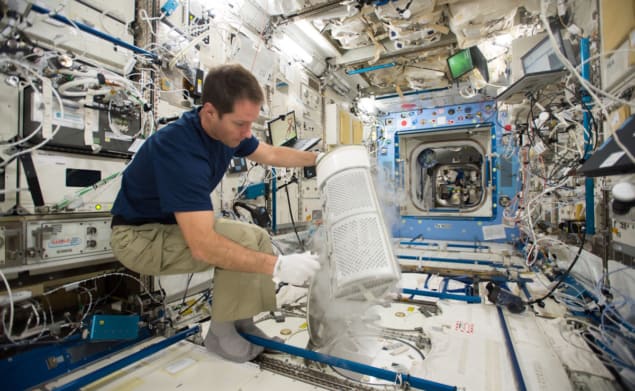
Life in space subjects the human body to extreme conditions – exposing astronauts to radiation, inducing fluid shifts and removing physical forces on the skeleton. Space flight can also cause haemolysis, the destruction of red blood cells, leading to “space anaemia”.
To investigate the health implications of long-duration spaceflight, researchers at the University of Ottawa studied 14 astronauts returning from six-month missions on the International Space Station. In particular, they examined changes in the astronauts’ bone marrow before and after their missions. The study, reported in Nature Communications, revealed that space travel depletes red blood cells and bone, but that upon return to Earth, the body recovers with the help of fat stored in the bone marrow.
“We found that astronauts had significantly less fat in their bone marrow about a month after returning to Earth,” says senior author Guy Trudel from University of Ottawa and The Ottawa Hospital in a press statement. “We think the body is using this fat to help replace red blood cells and rebuild bone that has been lost during space travel.”
Recovering from spaceflight
The study included 11 male and three female astronauts. The participants underwent lumbar vertebrae MR imaging and spectroscopy roughly 100 days preflight, and approximately 41 days, six months and one year after returning to Earth. Using three quantitative MR techniques, Trudel and colleagues observed that 41 days after landing, the astronauts’ bone marrow fat had decreased by 4.2% from preflight values.
To investigate potential mechanisms for this reduction in bone marrow adiposity (BMA), the team explored whether it was associated with the astronauts’ recovery from space anaemia, as occurs when the return to Earth’s gravity triggers increased production of red blood cells. Three days after landing, blood sample analysis showed that the astronauts had 10.4% fewer red blood cells than before their space missions, confirming that they suffered from space anaemia.
At 41 days postflight, the researchers measured 18.9% higher concentration of reticulocytes (immature red blood cells) in the astronauts’ blood than at preflight. These changes were spatially and temporally correlated with changes in bone marrow fat, reinforcing the theory that BMA downregulation results from local consumption of fatty acids to support red blood cell production.
As well as losing red blood cells, astronauts also suffer from loss of bone mass, or “space osteopenia”. The researchers thus examined whether BMA reduction was also correlated with astronauts’ recovery from this condition upon re-exposure to gravity. They found that 41 days after landing, serum and urinary markers of bone formation were increased over baseline levels.
They also used dual-energy X-ray absorptiometry to examine vertebral bone mineral density before and after spaceflight. The astronauts lost an average of 0.03±0.03 g/cm2 vertebral bone mass at 3–18 days postflight compared with preflight. Six to nine months after landing, this had recovered somewhat, but was still slightly below baseline levels. These findings support a second possible mechanism for BMA downregulation – the local use of fatty acids to supply energy-intensive bone formation in response to space osteopenia.
“Since red blood cells are made in the bone marrow and bone cells surround the bone marrow, it makes sense that the body would use up the local bone marrow fat as a preferential source of energy to fuel red blood cell and bone production,” explains Trudel. “We look forward to investigating this further in various clinical conditions on Earth.”
Sex-specific differences
The researchers found that the bone loss was only statistically significant for the male astronauts, which prompted them to explore potential sex-specific changes in BMA after long-duration spaceflight. On Earth, premenopausal women generally have lower BMA than men and, in this cohort, the female astronauts had 11.1% lower lumbar bone marrow fat at preflight than the male astronauts.
At 41 days postflight, female and male astronauts showed identical downregulation of lumbar BMA. However, measurements at six months and one year revealed that while male astronauts’ BMA progressively returned to normal levels, BMA accrued considerably in female astronauts. MR data showed that at one-year postflight, the male–female difference had disappeared. The researchers suggest that this sex-specific modulation of BMA merits further investigation in larger populations.

Life in space impacts human brain structure
The team also tested the impact of astronaut age on vertebral BMA modulation after long-duration spaceflight. They found that the younger the astronaut, the larger the decrease in bone marrow fat 41 days after landing.
The researchers emphasize that these findings in astronauts can also help people on Earth, such as patients with anaemia who have lost muscle and bone mass after long-term illness and limited mobility. “I’m hopeful that this research will help people recover from immobility on Earth as well as in space,” says Trudel. “Our research could also shed light on diseases such as osteoporosis, metabolic syndrome, aging and cancer, which are associated with increases in bone marrow fat.”
- SEO Powered Content & PR Distribution. Get Amplified Today.
- PlatoData.Network Vertical Generative Ai. Empower Yourself. Access Here.
- PlatoAiStream. Web3 Intelligence. Knowledge Amplified. Access Here.
- PlatoESG. Automotive / EVs, Carbon, CleanTech, Energy, Environment, Solar, Waste Management. Access Here.
- PlatoHealth. Biotech and Clinical Trials Intelligence. Access Here.
- ChartPrime. Elevate your Trading Game with ChartPrime. Access Here.
- BlockOffsets. Modernizing Environmental Offset Ownership. Access Here.
- Source: https://physicsworld.com/a/study-in-astronauts-could-improve-health-in-space-and-on-earth/



